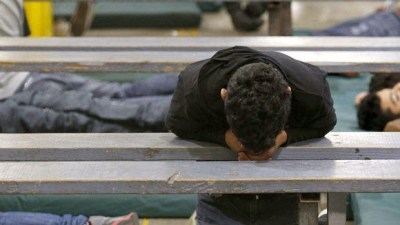The theme of the Alliance 2015 conference is Museums and Social Value. Leading up to that meeting in Atlanta, CFM will be hosting a number of guest bloggers addressing various aspects of museums and social justice. Last month, Robert Janes led off with a post on museums’ role in addressing social and environmental threats. For our second post in this series, Gretchen Jennings, who has blogged for several years about the need for “empathetic museums,” volunteered to address an issue currently getting much attention in the press: undocumented, unaccompanied children crossing the US border.
Why should this question be raised?
In a quick and unscientific poll of other museum professionals, especially those who work with children’s museums or with refugee groups, I find that I’m not alone in asking “what role, if any, should museums play in this national crisis?” But as Elaine Gurian and others have observed, museums are not noted for (nor expected to have) immediate responses to current events, and history museums in particular pride themselves on developing reasoned analysis with the passage of time. There is little in our traditional structures that lends itself to timely responses to current situations. If we museums want to become more actively involved with our communities, especially in our fast-paced global society, we may have to develop a new process and timeline for being responsive. However, while the issue of undocumented, unaccompanied children is one that may seem to have appeared suddenly, it actually has deep roots in many of the communities we serve. And this situation, while most urgent at the border, is gradually and inexorably moving into the entire country as groups of children are being taken in by humanitarian groups in other states.
It seems to me that museums might help the country to address this issue in two ways: by providing humanitarian assistance in collaboration with experienced agencies already working in the field, and by fostering discussion and dialogue in a safe and structured environment.
Collaborative humanitarian assistance
For museums in states and regions housing the families and unaccompanied children in this most recent wave of undocumented immigration perhaps the most welcome contribution would be organizing activities and programming. From what I have read, many children pass weeks or months in shelters with little or nothing to do. Museums are expert at engaging minds, imaginations, and bodies in art, science, and other aspects of the world. In doing this, museums might make the time in limbo go faster, providing some relief from the stress of confinement and separation. Museums positioned to provide such assistance might include those that already have:
- Staff who are experienced in working with families and children–getting their attention, engaging their minds and bodies; creating, tinkering, working in groups or alone
- Kits, packets, activities, and workshops already prepared; traveling science activities; perhaps some hardy specimens from live collections
- Access to materials needed for these activities
- Devoted volunteers
- Staff and volunteers with bilingual skills.
Collaborating with other relief organizations could help museums effectively deploy their resources within existing structures for aid. The Houston office of the Children’s Defense Fund recommends working with humanitarian organizations such as the Red Cross or Catholic Charities that are already on the scene. They also recommended contacting staff of the members of Congress working on this issue. Museums might also identify and partner with other local nonprofits that provide aid to immigrants. Funders such as MacArthur and the Ford Foundation that already support such efforts might be willing to provide support to add museum assistance to this mix as well.
Involvement through Dialogue: Museum as Forum
In addition to meeting the immediate needs of children being detained, museums can help their communities to explore this specific issue as well as more general issues surrounding immigration and immigration policy in the U.S. Many museums are already engaged in such work, for example through the The National Dialogues on Immigration Project which launched in January of this year, facilitated by the International Coalition of Sites of Conscience. This public initiative uses historical perspective to foster dialogue among people with diverse perspectives and backgrounds through encounters with the past. (Training on how to create and conduct dialogue programs is provided by the Sites of Conscience Coalition. Contact Sarah Pharaon, Coalition Program Director for North America, for more information.)
One example of a museum engaged in such work is the
Museum of International Folk Art in Santa Fe, which houses the Gallery of Conscience—an experimental interactive space that uses folk art as a catalyst for conversation and engagement on social justice and human rights issues of our times. Their latest exhibition, Between Two Worlds: Folk Artists Reflect on the Immigrant Experience, “draws on the work of international, immigrant, native Hispanic New Mexican, refugee, and native traditional artists to explore issues of home, place, displacement and belonging from different points of views and distinct histories: those who leave to find a new home, those left behind, and those who welcome newcomers in their midst–or not.” Gallery director Suzanne Seriff notes “The issue of the children crossing the border has come up in these conversations with the community kids over and over this week, and our exhibit has proven to be a rich platform to spark these discussions especially with a couple of the pieces of art [that directly address immigrant themes.]”
 |
Painting by folk artist Cenia Gutierrez Alfonso
from Cuba depicting a child crossing the Atlantic
on her own with her beloved gallo (rooster) in hand.
Photo by Museum of International Folk Art |
Are there Risks?
Museums located in areas where immigrant communities are large and growing no doubt serve audiences with varying views on how and even whether the U.S. should continue to accept and process immigrants in general and these children in particular. Museums considering involvement either in collaborative work with humanitarian organizations or by initiating dialogue and discussion about this dilemma may face strong opposition from their boards and/or members. This is, it appears, the price of taking on almost any difficult topic, whether it is controversial exhibition content or, as in this instance, linking mission, collections, and programming to complex events in the civic sphere. In deciding whether and how to play a role in either helping the children caught in this terrible situation, or in taking the lead in fostering discussion about immigration policy per se, a museum should be guided by its mission, and by the best judgment of its staff and board.
I am sure there are as many opinions among us museum folk as there are in the communities we serve. Your thoughts and comments are welcome. Also any specific experiences such as the one shared by the Museum of Folk Art in Santa Fe would be so helpful. I look forward to the conversation.
Gretchen has worked in museums for over 30 years as an educator, administrator, and exhibition project manager. Since 2007 she has served as Editor of Exhibitionist, the journal of AAM’s National Association for Museum Exhibition. The opinions she expresses in her blog and in this guest blog are her own and are not presented in any official capacity. You can find her posts on the need for and the qualities of The Empathetic Museum at Museum Commons blog. She can be contacted at gretchenjennings@rcn.com or on Twitter @gretchjenn.
Elizabeth Merritt











